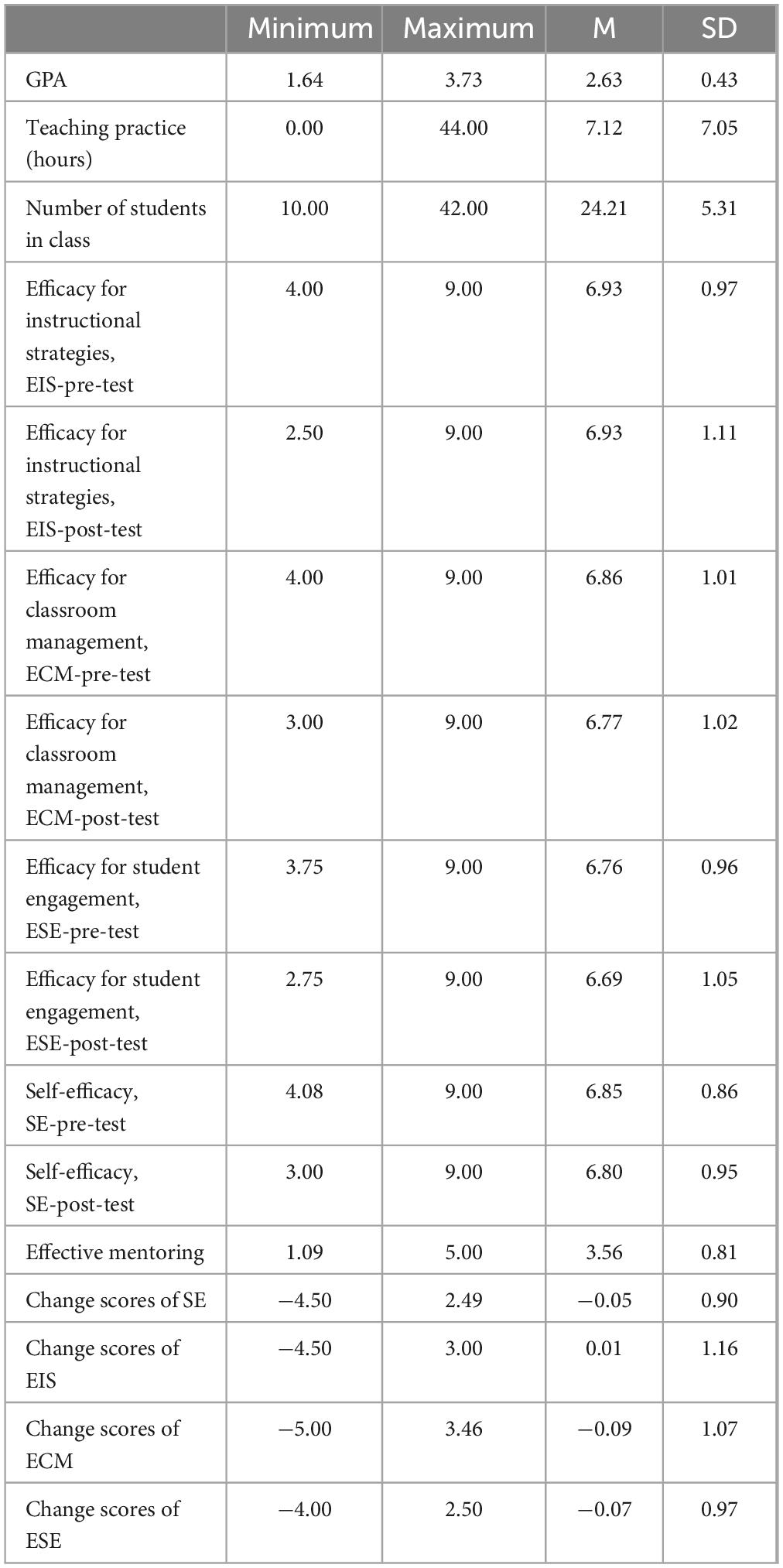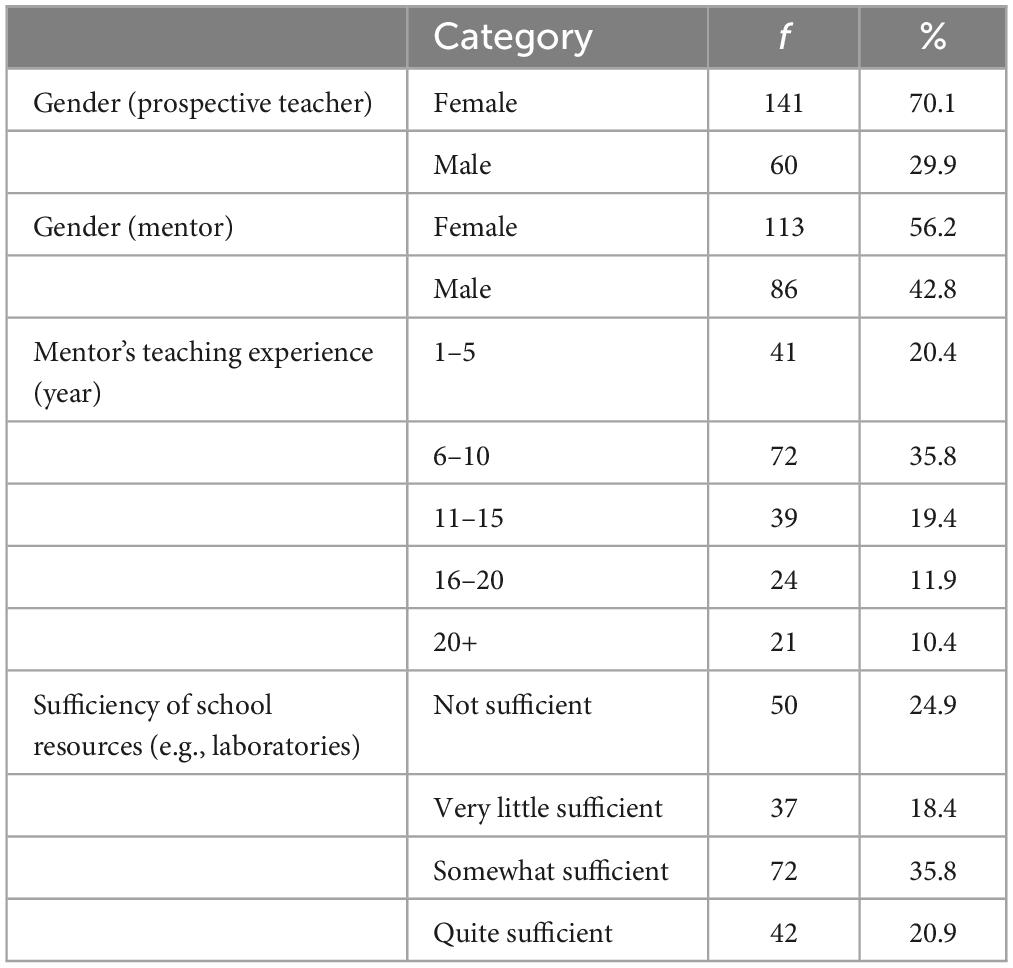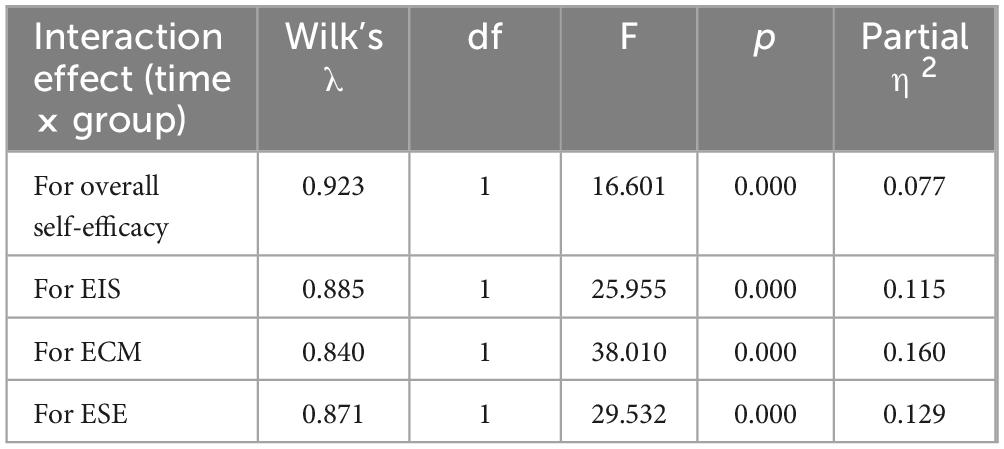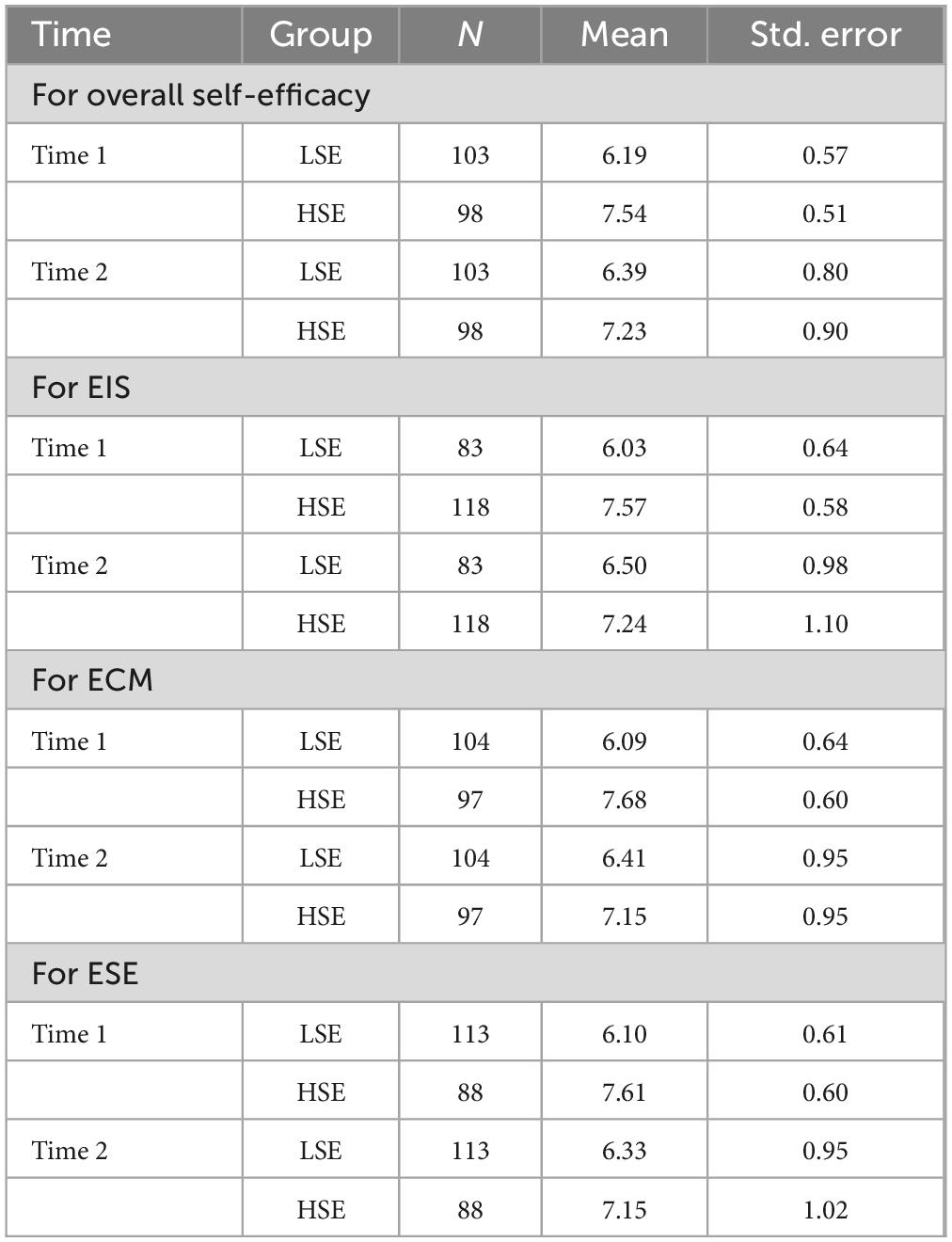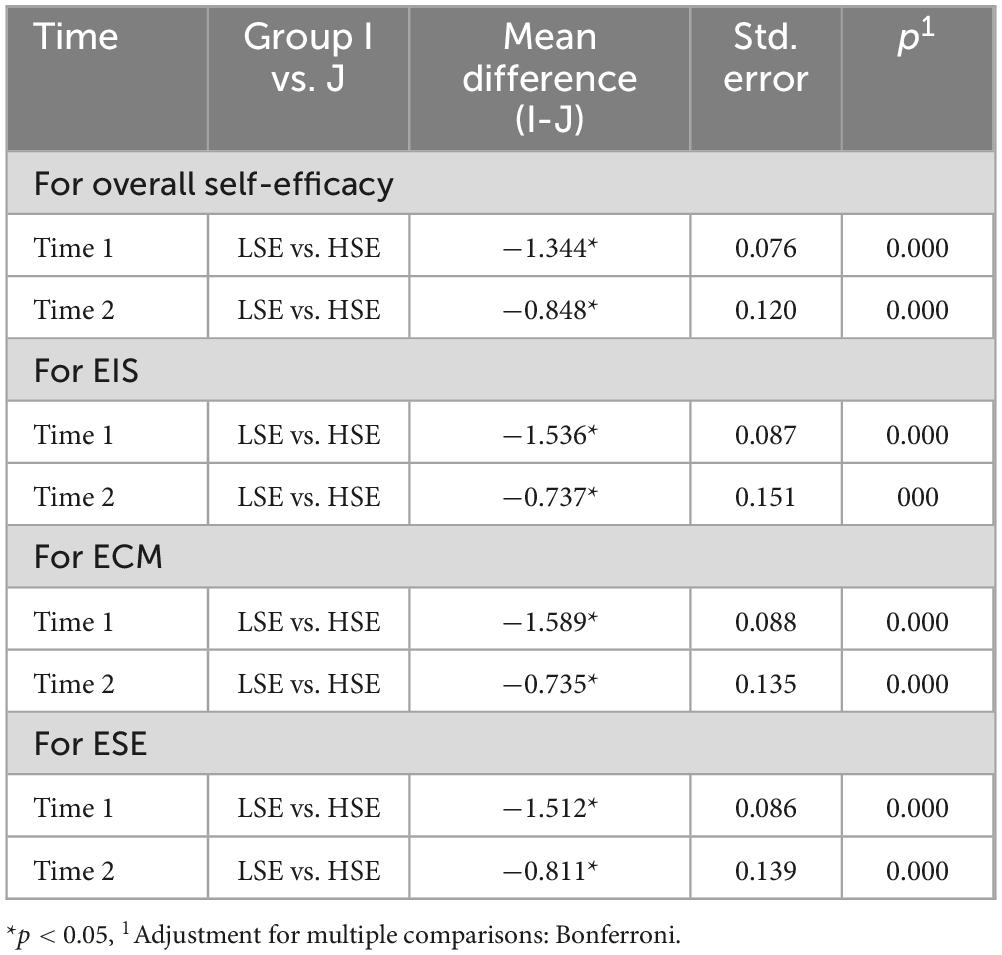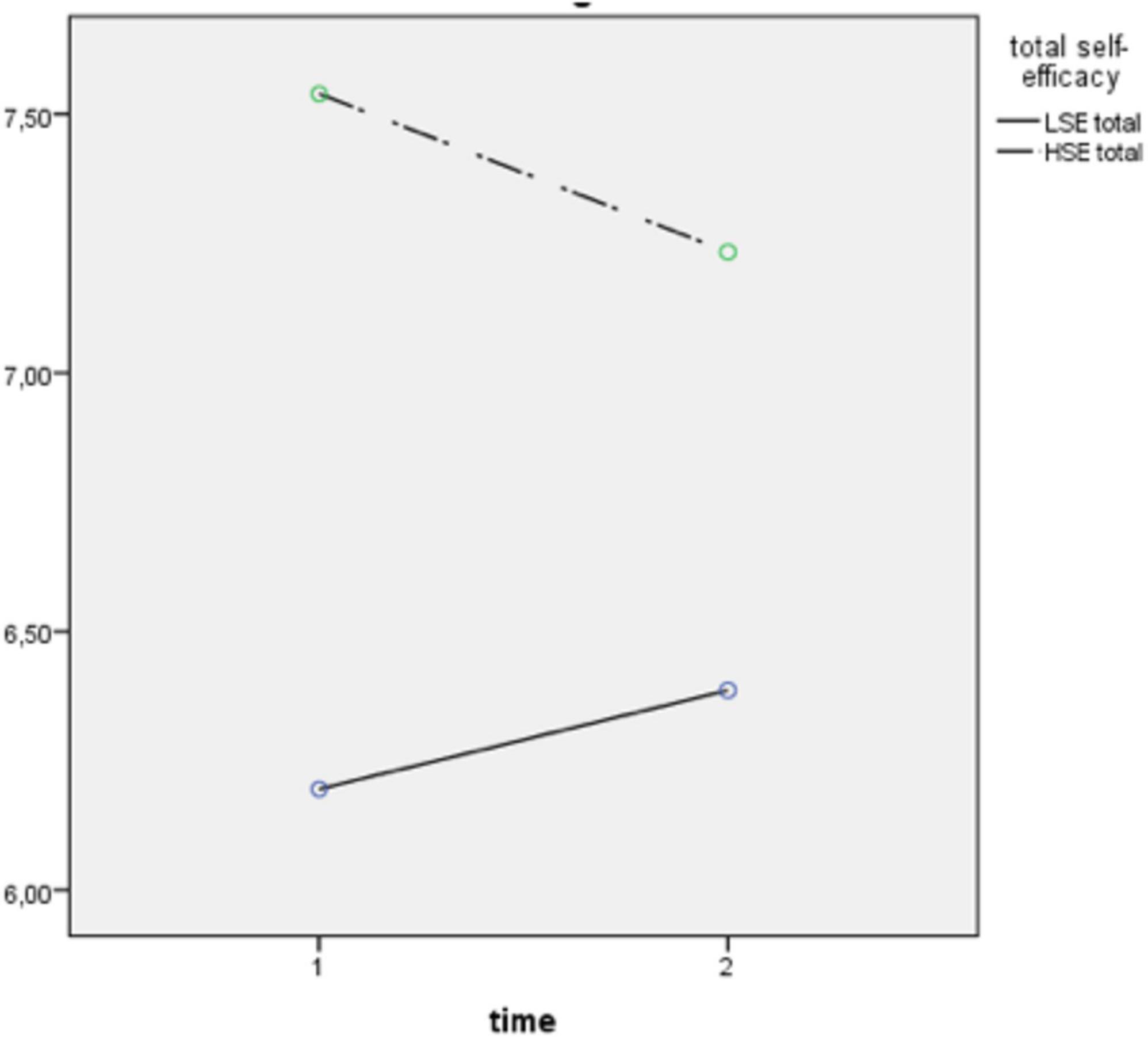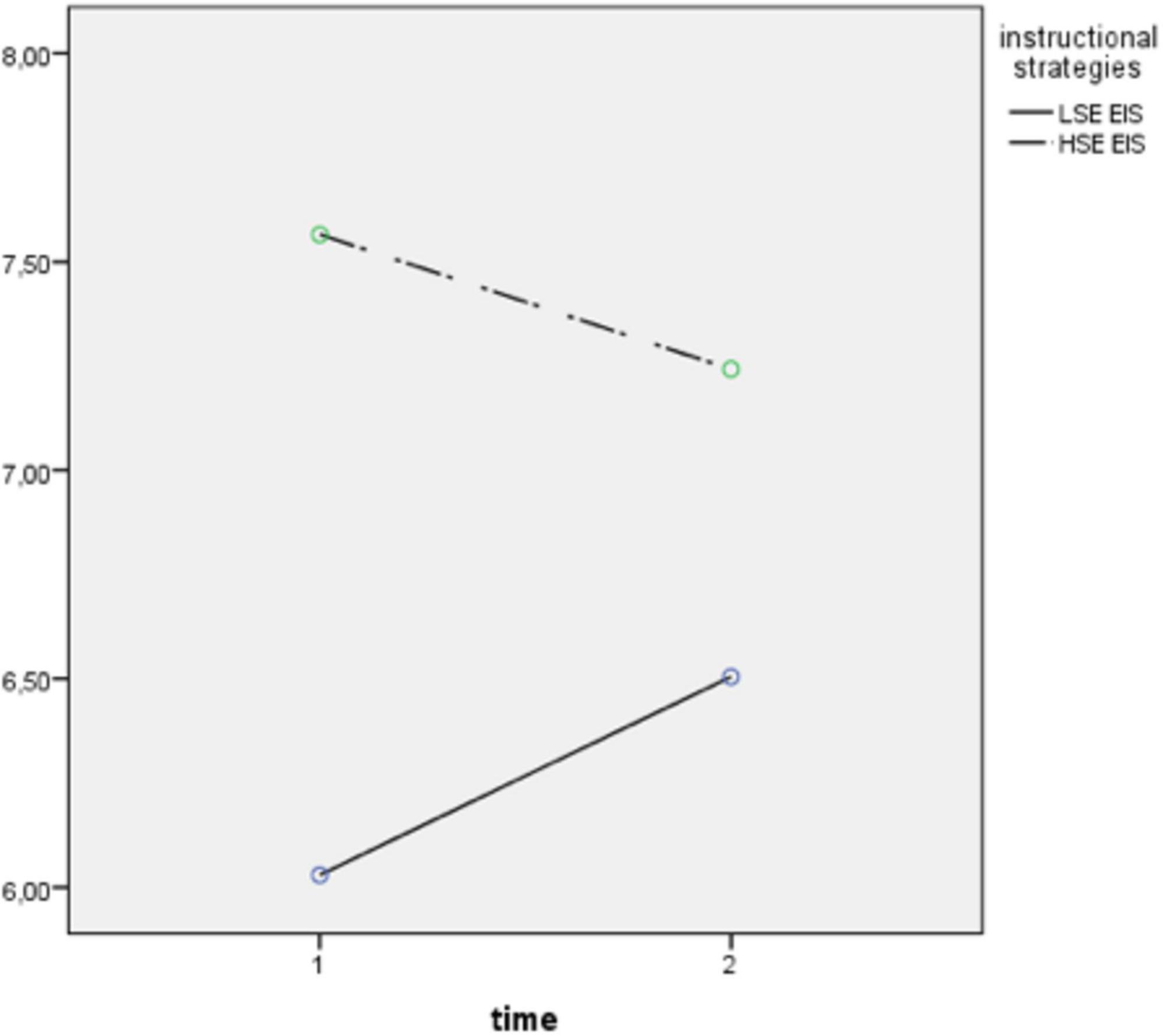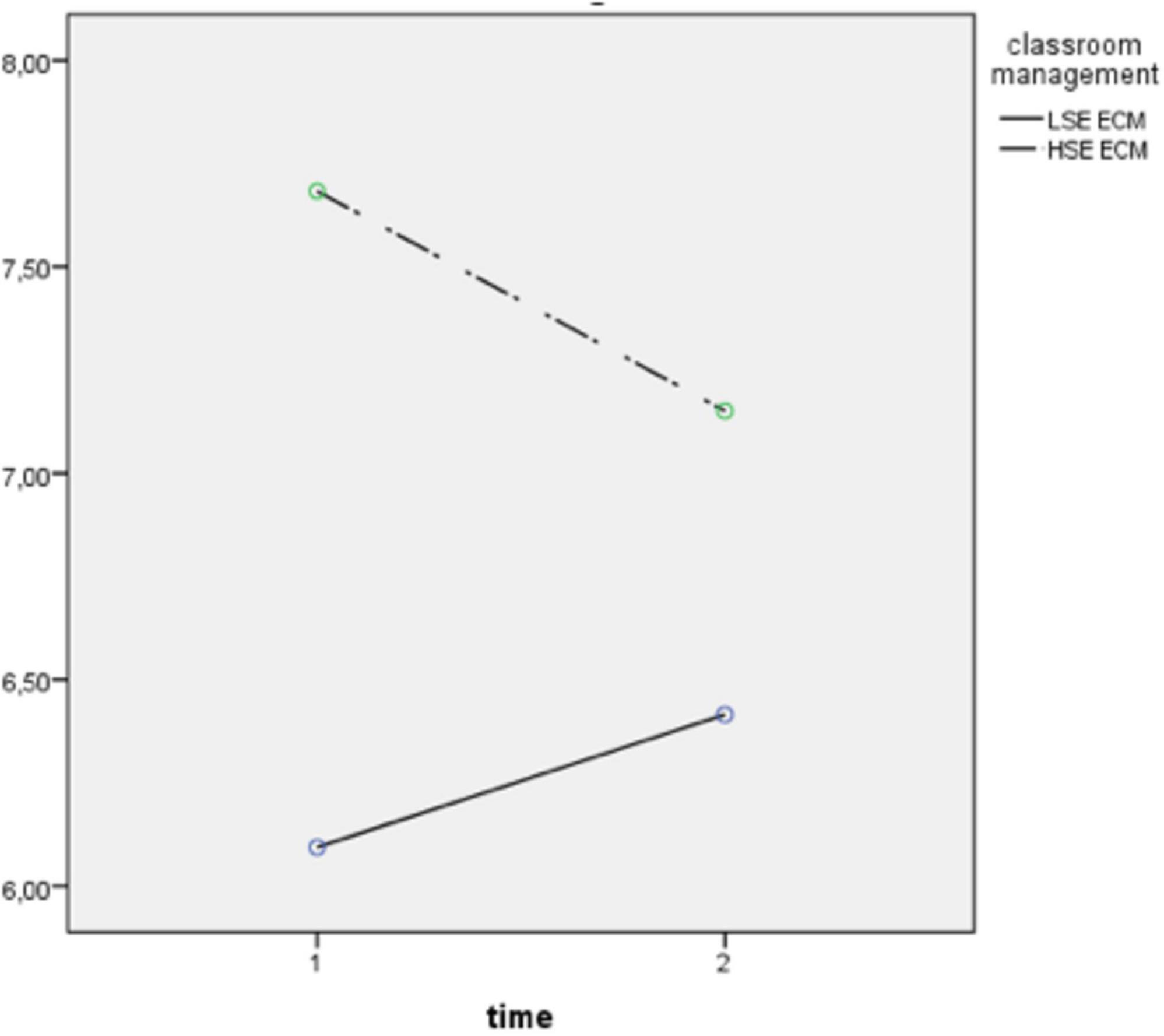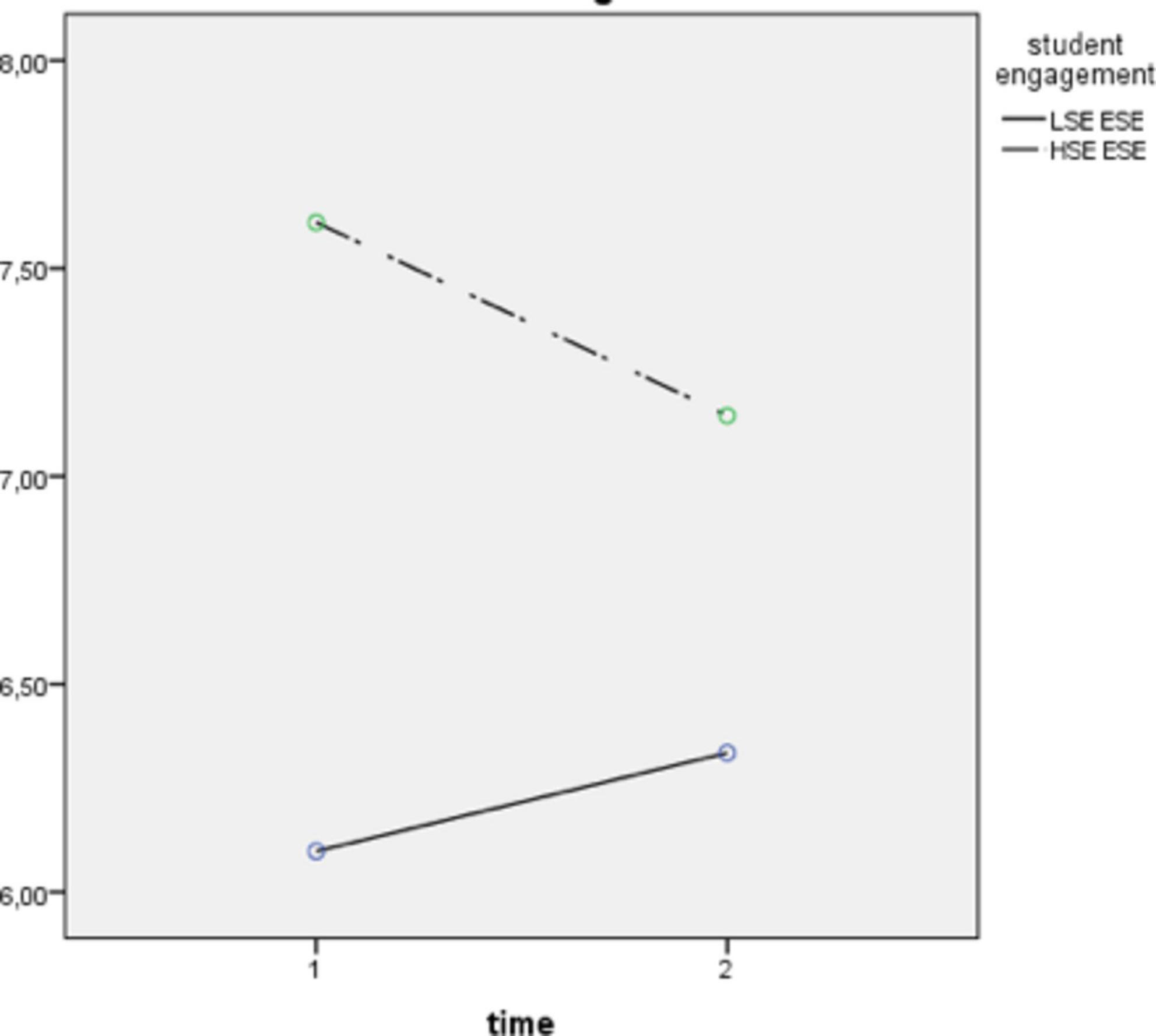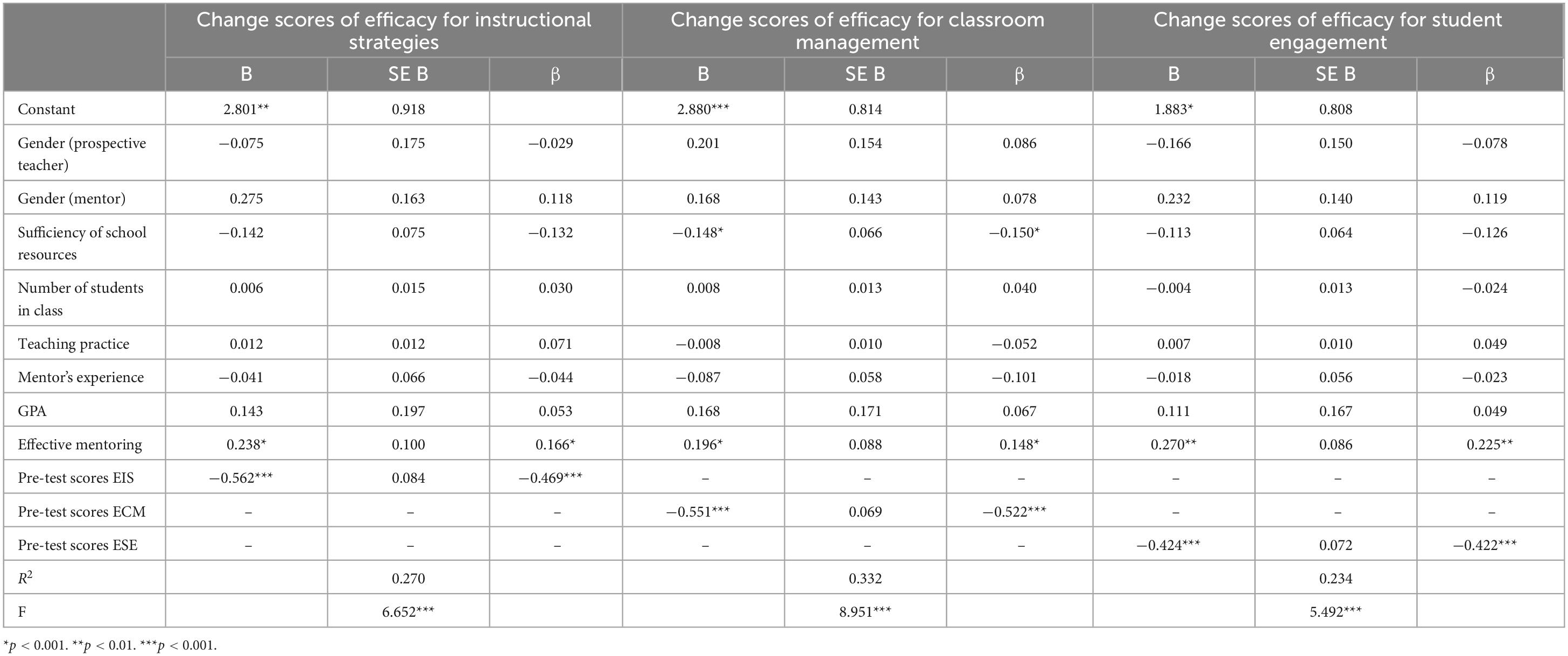- 1Department of Mathematics and Science Education, Kafkas University, Kars, Türkiye
- 2Department of Mathematics and Science Education, Atatürk University, Erzurum, Türkiye
- 3Department of Mathematics and Science Education, Trakya University, Edirne, Türkiye
This study is driven by a dual objective. Firstly, it aims to scrutinize the trajectory of self-efficacy beliefs among prospective science teachers before and after their participation in the Teaching Practicum Course which was conducted for 14 weeks. To accomplish this, 201 senior prospective teachers were stratified into low and high self-efficacy cohorts based on their pre-course overall self-efficacy and sub dimensions of self-efficacy (i.e., efficacy for student engagement, instructional strategies, and classroom management) assessments. Subsequently, a mixed between-within-subjects ANOVA was employed to ascertain whether significant differences existed between these groups, utilizing post-course self-efficacy scores. Secondly, this study attempts to explore the factors influencing prospective teachers’ self-efficacy beliefs within the scope of self-efficacy sources. To this end, predictor variables such as the number of courses taught by prospective teachers, class sizes, adequacy of school resources, the level of mentorship received, and initial efficacy levels were incorporated, and multiple linear regression analyses were conducted. The findings revealed divergent trajectories in the self-efficacy alterations of low and high self-efficacy groups. Furthermore, it was found that variables such as initial efficacy levels, effective mentoring, and adequacy of school resources significantly explained shifts in self-efficacy. These findings are discussed within the context of related literature.
Introduction
Given the increasing acknowledgment of the relationship between elevated self-efficacy in teaching and the quality of teaching practices, there is a growing interest in identifying the determinants contributing to the formation of these beliefs (Morris et al., 2017). Among these determinants, the initial phase of teacher education emerges as a crucial area warranting investigation. Atay (2007) underscores the imperative of identifying avenues to enhance the efficacy beliefs of prospective teachers during their teacher education programs. Throughout their initiation into the teacher education, prospective teachers encounter several experiences that shape their self-efficacy perceptions regarding teaching. Primarily, they engage in foundational coursework aimed at bolstering subject proficiency and broadening their pedagogical knowledge through specialized professional development courses pertinent to their teaching field. Furthermore, they undertake teaching practicum activities within authentic classroom settings to apply theoretical knowledge in practical contexts. During this process, they receive mentoring from the teacher which also have a potential to influence their self-efficacy development (Philippou and Charalambous, 2005; Yerdelen and Sungur, 2019). It is plausible that various factors exert varying degrees of influence on teaching self-efficacy, necessitating a careful examination of each facet to refine the teacher education process. Central to this discourse, this study endeavors to elucidate the impact of instructional processes during the teaching practice course (TPC) on the teaching self-efficacy of prospective teachers within the Social Cognitive Theory framework of sources of self-efficacy. The motivation behind this inquiry lies in the potential to glean insights that can inform enhancements in initial teacher education programs, thereby fortifying the self-efficacy of future educators.
Theoretical framework
Social Cognitive Theory emphasizes human functioning as the outcome of reciprocal interactions among personal, behavioral, and environmental factors (Bandura, 1986). These factors influence and are influenced by each other. Within this framework, Bandura (1986) defines self-efficacy as “people’s judgments of their capabilities to organize and execute courses of action required to attain designated types of performance” (p. 391). Social Cognitive Theory identifies four sources from which self-efficacy beliefs are developed: mastery experiences, vicarious experiences, social persuasion, and emotional/physiological states (Bandura, 1997). Generally speaking, individuals’ self-efficacy levels improve when they experience success in performing tasks, observe the performances of similar individuals and compare them with their own performances, receive constructive feedback and praise from others they are valued, and perceive positive emotional and physical state while judging their abilities (Bandura, 1977, 1997). This study aims to identify the factors influencing prospective science teachers’ self-efficacy development by considering the sources of self-efficacy addressed within the Social Cognitive Theory framework.
Literature review
Teacher self-efficacy
Teachers’ self-efficacy in the realm of pedagogy holds significant importance as it profoundly influences their effectiveness in the classroom (Tschannen-Moran and McMaster, 2009). Self-efficacy, plays a pivotal role in facilitating various instructional methodologies, fostering student engagement, managing classroom dynamics, and fostering receptivity to innovative teaching approaches (Woolfolk et al., 1990; Kavanoz et al., 2015). Tschannen-Moran and Woolfolk Hoy (2001) define teacher self-efficacy as a teacher’s “judgment of his or her capabilities to bring about desired outcomes of student engagement and learning, even among those students who may be difficult or unmotivated” (p. 783). Teaching self-efficacy is recognized as a multi-dimensional construct with the dimensions of instructional strategies, student engagement, and classroom management (Tschannen-Moran and Woolfolk Hoy, 2001; Fackler et al., 2021). Efficacy for instructional strategies refers to the level of confidence that teachers have while utilizing a range of instructional techniques and providing alternative explanations in order to improve teaching effectiveness. Efficacy for student engagement refers to how confident teachers are in their ability to engage all students and motivate them to achieve academic success. Finally, efficacy for classroom management is determined by how confidently classroom dynamics are managed and disruptive behavior is mitigated (Tschannen-Moran and Woolfolk Hoy, 2001). Numerous studies have affirmed that these three dimensions of teacher self-efficacy are widely recognized and frequently examined in the literature (Skaalvik and Skaalvik, 2007; Klassen et al., 2011).
Acknowledged as a fundamental determinant of teaching efficacy (Klassen and Tze, 2014) and students’ academic achievements (Caprara et al., 2006; Zee and Koomen, 2016; Perera and John, 2020), self-efficacy is closely intertwined with teachers’ professional wellbeing. Namely, highly efficacious educators tend to experience heightened job satisfaction (Caprara et al., 2006; Kasalak and Dağyar, 2020; Perera and John, 2020), greater commitment to their profession (Chesnut and Cullen, 2014), and reduced susceptibility to burnout (Skaalvik and Skaalvik, 2007; Zee and Koomen, 2016) compared to their counterparts with lower self-efficacy levels. Furthermore, there exists a notable correlation between teacher self-efficacy and work engagement; educators who have a greater sense of assurance about their pedagogical abilities are reported to show higher levels of enthusiasm in their teaching responsibilities, put more dedication and effort into their professional endeavors, and develop more robust interpersonal relationships with both colleagues and students (Klassen et al., 2013; Yerdelen et al., 2018). Similarly, teachers’ high self-efficacy has potential to help them to use proactive coping strategies for overcoming with stressful situations related to their profession (Verešová and Malá, 2012; Samfira and Paloş, 2021). Teachers with higher levels of education and seniority were found to be more efficacious than teachers with lower levels of education and seniority, respectively, which indicated that as teachers’ knowledge in the field increases, their beliefs about their abilities in executing instructional practices increase (Orakcı et al., 2023). Fostering high levels of self-efficacy among educators is imperative for cultivating a cadre of motivated and effective teachers within educational institutions. Although efforts to bolster self-efficacy may occur during in-service training, scholarly evidence underscores the significance of the formative years in shaping efficacy beliefs (Bandura, 1977), with established beliefs displaying resilience to change (Tschannen-Moran et al., 1998). A recent systematic literature review on the factors influencing teacher self-efficacy for inclusive education pointed out that practicum experience in prospective teacher education is influential on teachers’ self-efficacy beliefs (Wray et al., 2022). As Martins et al. (2015) emphasize, the existing literature presents conflicting findings regarding the trajectory of self-efficacy throughout teacher education programs, attributing increases to the effectiveness of teaching practice while acknowledging potential decreases owing to disparities encountered during practicums. Given that the cultivation of teaching self-efficacy commences during initial teacher education, providing support to prospective teachers in developing robust self-efficacy beliefs assumes paramount importance for their future professional endeavors.
Sources of self-efficacy during teaching practice course
Acknowledging the pivotal role of teacher self-efficacy, Gale et al. (2021) advocate for further inquiry into the origins of self-efficacy beliefs. As mentioned above, within the framework of Social Cognitive Theory (Bandura, 1997), four primary sources of self-efficacy are delineated: mastery experiences, vicarious experiences, social persuasion, and physiological and emotional states. Arslan (2019) emphasizes the transformative impact of the teaching practice course on self-efficacy in terms of sources of self-efficacy for prospective teachers. Previous research highlights mastery experiences and social persuasion as the primary sources with the greatest potential to influence prospective teachers’ self-efficacy (Mulholland and Wallace, 2001; Onofre and Jardim, 2008). In the context of this investigation, the first three sources are scrutinized, given their susceptibility to influence within the teaching practice course (TPC) milieu.
Mastery experiences entail the cultivation of self-efficacy through the execution of novel tasks, compared with previous performances (Bandura, 1997). Throughout the TPC, prospective teachers engage in teaching activities within authentic classroom settings, complemented by pre-practicum micro-teaching sessions at the university. The accumulation of successful teaching experiences during these practices is anticipated to bolster self-efficacy in preparation for future teaching endeavors. Conversely, if these experiences prove unsuccessful due to various factors such as challenges in classroom management, gaps in content knowledge, or inefficacies in applying teaching methodologies, they may precipitate a decline in their self-efficacy. Tschannen-Moran et al. (1998) contend that prospective teachers often underestimate the complexities inherent in teaching, harboring overly optimistic sentiments before confronting the realities of classroom instruction. As they navigate the teaching landscape during the TPC, prospective teachers may witness a decrement in their self-efficacy toward teaching, as they come to grips with the dissonance between their preconceived standards and their actual performance (Tschannen-Moran et al., 1998). Consequently, the TPC affords prospective teachers invaluable opportunities to gain insights into their own teaching abilities. In this study, mastery experiences are elucidated through the cumulative teaching hours accrued throughout the semester, symbolizing the prospective teachers’ immersion in authentic classroom settings.
Vicarious experiences entail the development of efficacy beliefs through observation and comparison of one’s own performance with that of others (Usher and Pajares, 2009). Effective mentorship is deemed important in providing exemplary models for prospective teachers, with mentors’ competencies, behaviors, and communication skills exerting considerable influence (Jonson, 2008). Within the TPC, prospective teachers observe mentor teachers’ instructional practices, gaining insights into classroom management, instructional techniques, and professional interactions. Therefore, it can be expected that seeing that the mentor teacher is successful through continuous efforts increases the prospective teachers’ belief that they have the skills to master the teaching profession. Moulding et al. (2014) stated that the role of vicarious experiences on prospective teachers’ self-efficacy development is not clear in the literature yet.
Lastly, social persuasion entails the reinforcement of self-efficacy through affirming feedback from authoritative figures (Usher and Pajares, 2009). Tschannen-Moran et al. (1998) caution against the potential negative impact of trial-and-error experiences on prospective teachers’ self-efficacy, underscoring the importance of effective mentorship during the teaching practicum. Verbal encouragement from the mentor teacher can help prospective teachers to believe that they have the necessary skills and abilities to succeed. Encouragement can lead people to try harder tasks, which increases the likelyhood of success. In their study, Moulding et al. (2014) found that verbal persuasion which is received in the form of verbal and written feedbacks from mentor teachers throughout student teaching practices is significantly correlated with high self-efficacy of prospective teachers. On the other hand, the social persuasion given by the mentor teacher can also be negative. For example, discouraging criticism from the teacher can damage self-efficacy. Thus, it is expected that guidance and constructive feedback from mentor teachers may foster self-efficacy among prospective teachers.
Mentoring
Notably, as highlighted by Martins et al. (2015), practicum experiences assume a pivotal role in shaping self-efficacy beliefs. The expectation that all prospective teachers receive high quality mentoring is emphasized by the teacher education programme in Turkiye (Ministry of National Education [MoNE], 2018). This high quality mentoring is also contribute to the development of self-efficacy among prospective teachers (Moulding et al., 2014). Hudson (2006) considers the dimensions of the mentoring for effective science teaching as personal attributes, system requirements, pedagogical knowledge, modeling and feedback. Accordingly, the personal attributes dimension addresses mentoring practices such as mentors being supportive, being comfortable talking about science teaching, listening to mentees with a supportive attitude, instilling confidence and positive attitudes in mentees, and helping mentees reflect on their teaching practices. System requirements includes practices such as mentors discussing the goals of science teaching with mentees, summarizing science curriculum documents, and discussing science policies. Pedagogical knowledge includes mentors guiding mentees through preparation and planning; assisting them with instructional timetabling; guiding them in classroom management, instructional strategies and planning; discussing their practices and knowledge; providing different perspectives; and discussing questioning techniques, assessment and problem solving. The mentoring practices covered under the modeling dimension include modeling rapport with students; demonstrating enthusiasm for teaching; modeling a well-planned lesson, classroom management, effective science teaching, and hands-on lesson; and modeling the use of science syllabus language. Finally, the feedback dimension includes the practices of the mentor observing the mentee’s lesson, providing oral and written feedback, reviewing their lesson plans, evaluating their teaching, and expressing their expectations from mentees.
In their literature review study, Ellis et al. (2020) addressed factors associated with high-quality prospective teacher mentoring. Accordingly, mentors should facilitate prospective teachers’ learning by encouraging them to be inquiry-oriented, model effective teaching, and make connections between theory and practice. A meta-analysis study of (quasi-) experimental studies revealed that mentoring influences instructional skills such as lesson planning and clarity of instruction of prospective teachers (Mok and Staub, 2021). A recent meta-analysis showed that individual support activities such as modeling, reflection, and feedback on lesson plans or lessons significantly influence prospective and beginning teachers’ self-efficacy with a medium effect size (Mok et al., 2023). Moreover, as it is indicated in Burger (2024) longitudinal study with 138 beginning teachers, collaborative mentoring approaches that are aligned with constructivist learning principles and provide opportunities for reflection on practice benefit the self-efficacy of prospective teachers, and transmissive mentoring appears to have ignored all sources of self-efficacy, which runs counter to the notion that such an approach may at least give mentees vicarious experiences.
The rationale of the study
Given that teacher education encompasses highly complex processes, including coursework and practical applications, it necessitates meticulous research at each stage to ensure its effectiveness. Recognizing the significant influence of teaching practice courses on prospective teachers’ self-efficacy, as indicated by Martins et al. (2015), future inquiries may delve deeper into the nuanced effects of diverse teaching practice experiences on self-efficacy. As mentioned above, the TPC encompasses the processes of mentoring prospective teachers, facilitating their instruction in real classroom settings, and enabling them to experience teaching within its natural environment. Effective mentoring is deemed imperative for prospective teachers as they navigate real classroom settings, wherein they benefit from exemplary role models and constructive feedback from experienced mentors (Ellis et al., 2020; Mok et al., 2023). Through effective mentoring, prospective teachers can enhance their proficiency in preparing lesson plans, selecting and implementing instructional strategies, managing classroom dynamics, and grasping curriculum intricacies (Hudson, 2006). Consequently, mentoring can be conceptualized within the framework of two pivotal sources: vicarious experiences and social persuasion, while the act of teaching in authentic classroom environments embodies mastery experiences. Moreover, Tschannen-Moran et al. (1998) underscore the nuanced nature of teaching practices and advocate for commencing teaching endeavors in less complex settings, such as classrooms with smaller student cohorts and well-resourced schools. As seen, there are many variables that can affect teaching self-efficacy in teaching practicum process and more studies are needed to better understand the impact of these variables. Social Cognitive Theory (Bandura, 1986) provides a strong framework for this phenomenon by identifying four sources that feed self-efficacy. Thus, in this study, we explore the determinants of the changes in prospective science teachers’ self-efficacy throughout teaching practicum from the perspective of sources of self-efficacy within the Social Cognitive Theory framework.
Furthermore, in line with the tenets of aptitude-treatment interaction (ATI) research, individual differences, including motivational proclivities, assume significance and warrant consideration when assessing the impact of instructional approaches on student outcomes (Koran and Koran, 1984). The authentic classroom milieu may not always align seamlessly with the theoretical constructs imparted during initial teacher education, prompting prospective teachers to confront their preconceived notions regarding their aptitude for handling classroom exigencies. Indeed, the actual classroom experience serves as a litmus test for evaluating the alignment between these beliefs and their actual performance, potentially shaping their self-efficacy perceptions accordingly. There are studies examining the changes in teaching self-efficacy beliefs of prospective teachers at different time points in their initial teacher education program (e.g., Menon and Azam, 2021; Ma et al., 2022). However, they did not consider whether prospective teachers with varied levels of initial teaching self-efficacy are influenced differently by the training they have received. Echoing the sentiment articulated by Martins et al. (2015), who lament the dearth of clarity regarding the influence of practicum experiences on teachers’ self-efficacy development, this study seeks to elucidate whether prospective teachers with different levels of self-efficacy are comparably affected by the teaching practice course.
Central to the aforementioned discourse, the present study endeavors to investigate potential shifts in prospective science teachers’ (PSTs) self-efficacy toward teaching before and after their engagement in the teaching practice course (TPC), while also identifying the factors influencing these changes. Specifically, the following research questions are posed:
1. Is there a statistically significant interaction between membership in either the low self-efficacy (LSE) or high self-efficacy (HSE) groups and time concerning PSTs’ post-course self-efficacy beliefs?
2. Are there significant mean differences between the LSE and HSE groups regarding PSTs’ self-efficacy beliefs both before (Time 1) and after (Time 2) undertaking the TPC?
3. Do significant changes exist in the self-efficacy beliefs of PSTs within the HSE and LSE groups before and following the completion of the TPC?
4. Which demographic and contextual variables serve as predictors for the alterations observed in PSTs’ teaching self-efficacy?
These research questions are posed not only in the context of overall self-efficacy but also extend to its constituent dimensions.
Materials and methods
Participants
The study comprised 201 senior prospective teachers with a gender distribution of 70% female and 30% male, enrolled in science teaching programs at three state universities situated in the eastern and northeastern regions of Turkiye. The selection of universities and participants was conducted via convenience sampling, facilitated by the involvement of the study’s authors, who held positions as faculty members within these academic institutions. The participants’ ages ranged from 20 to 22 years, with a mean age of 22.6 years and a standard deviation of 1.35 years. Furthermore, their Grade Point Averages (GPAs) varied between 1.64 and 3.73 out of 4, with a mean GPA of 2.63 and a standard deviation of 0.43. The PSTs were actively engaged in teaching practice course, wherein they administered instructional sessions within authentic classroom settings. This study was carried out within the scope of the teaching practice course, which takes place in the last semester of prospective teachers’ four-year teacher education, and the study covers the entire 14-week course period.
Initial teacher education and teaching practice course in Turkiye
Prospective teacher education in Turkiye is overseen by the Council of Higher Education (CHE), with teacher education programs offered at the Faculties of Education within universities. These programs typically span four years of undergraduate study. Additionally, individuals who have completed a four-year undergraduate degree in other fields (such as physics, mathematics, or chemistry) may also qualify for teaching positions by completing pedagogy courses offered by the Faculties of Education.
The undergraduate curriculum followed by education faculties is standardized by the CHE, with limited flexibility primarily confined to elective courses (approximately 25% of the curriculum). During the final year of their program, prospective teachers undertake the teaching practice course (TPC), allowing them to engage in practical teaching experiences within school settings. Notably, the duration of the TPC has been extended from one semester to two semesters with recent updates.
It is noteworthy that students aspiring to pursue teaching careers may gain admission to faculties of education following successful performance in the nationwide university entrance examination upon completing high school. Beyond this requirement, there are no additional selection criteria for entry into teacher training programs. However, upon graduation, individuals must undergo a nationwide selection examination and subsequent interview processes to qualify for teaching positions within public schools.
In the course of initial teacher training, prospective teachers engage in practical classroom settings during the final year of their four-year program, as delineated by the teaching practice course framework, established in collaboration with the Council of Higher Education [CHE] (2018) and the Ministry of National Education [MoNE] (2018). The Teaching Practice comprises a two-hour theoretical component, instructed by the designated faculty member at the university, alongside six hours of practical experience under the mentorship of an experienced teacher within the assigned school. The allocated teaching hours for mentees depend on the weekly schedule of the respective course, necessitating a minimum of 14 h for courses with 1–2 class hours and at least 24 h for those with three or more class hours. Throughout this engagement, mentees benefit from professional guidance provided by both faculty members and mentor teachers, encompassing various aspects such as pedagogical methods, classroom management, official protocols, and student interaction. Notably, a minimum of four lessons taught by the mentees undergo guided observation and evaluation by both mentor teachers and instructors, facilitating feedback on their instructional performance.
Data acquisition
In the present study, data collection during the TPC involved the administration of a demographic information form, the Teacher Self-Efficacy Scale, and the Mentoring for Effective Teaching Scale. Specifically, participants completed the demographic information form and Teacher Self-Efficacy Scale as pre and post-tests. The demographic questionnaire encompassed inquiries regarding the mentor’s gender and experience, as well as PSTs’ gender, Grade Point Average (GPA), cumulative teaching practice hours, average classroom size, and adequacy of school resources such as laboratory facilities. This form underwent meticulous preparation by the researchers, with expert consultation during its developmental phase.
The Teacher Sense of Self-Efficacy Scale, developed by Tschannen-Moran and Woolfolk Hoy (2001), was designed in both extensive (24 items) and abbreviated (12 items) formats. Capa et al. (2005) undertook the task of adapting the extensive version into Turkish. Respondents indicate their level of agreement on a 9-point Likert scale, ranging from “not confident” to “very confident.” The scale includes three sub-dimensions: efficacy for student engagement (ESE, example item: “How much can you do to get students to believe they can do well in schoolwork?”), efficacy for instructional strategies (EIS, example item: “To what extent can you use a variety of assessment strategies?”), and efficacy for classroom management (ECM, example item: “How much can you do to control disruptive behavior in the classroom?”). Capa et al. (2005) reported commendable internal consistency, with a Cronbach alpha coefficient of 0.93 for the overall scale, and 0.82, 0.86, and 0.84 for ESE, EIS, and ECM, respectively. Additionally, their confirmatory factor analysis provided support for the scale’s tri-dimensional structure, evidenced by fit indices such as TLI = 0.99, CFI = 0.99, and RMSEA = 0.06. In the current investigation, the decision to employ the abbreviated version of the scale aimed to mitigate participant burden. This version had previously undergone validation among science educators by Yerdelen (2013). Confirmatory factor analysis corroborated the validity of this version, with SRMR = 0.05, NNFI = 0.97, CFI = 0.98, and RMSEA = 0.08. Furthermore, the abbreviated scale exhibited reliability, as reflected by a Cronbach alpha coefficient of 0.89 for the entirety of the scale, and ranging from 0.76 to 0.83 for its constituent dimensions. Similarly, in the present inquiry, the internal consistency coefficient remained robust, with values of 0.88 for the overall scale, and 0.72, 0.74, and 0.76 for the ESE, EIS, and ECM dimensions, respectively.
The Mentoring for Effective Science Teaching Scale, developed by Hudson (2006), comprises 34 items rated on a 5-point Likert scale, ranging from “strongly disagree” to “strongly agree.” This scale evaluates the mentoring experiences of Prospective Science Teachers across five dimensions: personal attributes, system requirements, pedagogical knowledge, modeling, and feedback. An illustrative item from the scale is as follows: “During my final professional school experience in primary science teaching, my mentor was supportive of me for teaching science.” Yerdelen et al. (2012) undertook the translation and adaptation of the scale into Turkish. Despite the unidimensional factor structure revealed through exploratory factor analysis in Yerdelen et al. (2012) study, commendable internal consistency was demonstrated, with a Cronbach alpha coefficient of 0.98. Consistently, in the present investigation, the Cronbach alpha coefficient was similarly high, at 0.97. In the present study, Confirmatory Factor Analysis (CFA) with maximum likelihood estimation method using the LISREL 8.80 (Jöreskog and Sörbom, 2007) was conducted for the PSTs’ responses on the Mentoring for Effective Science Teaching Scale. Fit indices supported the unidimensional factor structure (χ2 / df = 2.708; SRMR = 0.061, NNFI = 0.967, CFI = 0.969, IFI = 0.969). Subsequently, this scale was administered to participants in the post-test phase. Elevated scores on the scale denote a high level of effective guidance provided by mentors at the practicum school.
Prior to the study, ethics committee approval was obtained from Kafkas University Social and Human Sciences Ethics Committee with the number 48553601-17, and the study was carried out with prospective teachers on a voluntary basis.
Data analysis
Preceding the data analysis, PSTs underwent stratification into two distinct groups based on their pre-test self-efficacy scores: the low self-efficacy (LSE) group and the high self-efficacy (HSE) group. Specifically, the mean score derived from the comprehensive self-efficacy scale was computed and utilized as the threshold for delineating these groups. Consequently, individuals scoring below this mean constituted the LSE group (recoded as 0), whereas those scoring above formed the HSE group (recoded as 1). This segmentation process was iterated for each sub-dimension of self-efficacy. There were 103 PSTs with self-efficacy scores lower than 6.85- the mean value- and they were specified in the LSE group while 98 PSTs had self-efficacy scores greater than 6.85 and were specified in the HSE group (the number of participants in the LSE and HSE groups for each sub-dimensions of self-efficacy can be seen in Table 5).
Mean values of both the overall self-efficacy and its constituent sub-dimensions are delineated in Table 1.
To address the initial three research questions, a mixed between-within-subjects ANOVA was employed. This choice was motivated by the nature of the independent variables involved: one, namely the affiliation with either the LSE or HSE group, was observed between subjects, while the other, time, was observed within subjects (Tabachnick and Fidell, 2007, p. 46). The first research query sought to examine the interplay between membership in LSE or HSE groups and temporal progression concerning PSTs’ self-efficacy beliefs upon completion of the course. Subsequently, the second and third research queries investigated the main effects of group and time, respectively. Specifically, to scrutinize disparities between LSE and HSE groups regarding PSTs’ self-efficacy beliefs pre- and post-course (second research question), pairwise comparisons of these groups at distinct time points were conducted. Similarly, alterations in self-efficacy beliefs among PSTs within HSE and LSE groups before and after the course were explored (third research question). Across these analyses, four distinct assessments were executed, focusing on dependent variables encompassing overall self-efficacy, EIS, ECM, and ESE. Before conducting the mixed between-within-subjects ANOVA, its assumptions were checked. Examination of skewness and kurtosis values, as well as histograms, revealed that the dependent variables were normally distributed; according to Box’s test of equality of covariance matrices, intercorrelations were homogenous; and as indicated by non-significant Levene’s test results, variances were equal.
Lastly, to ascertain whether demographic and contextual variables could predict shifts in PSTs’ teaching self-efficacy beliefs, four separate multiple linear regression (MLR) analyses were undertaken. Change scores, derived from the discrepancy between pre-test and post-test overall self-efficacy scores, and likewise for other dimensions, served as the dependent variable. Conversely, prospective teacher gender, mentor gender, adequacy of school resources, class size, number of teaching practice hours, mentor’s years of experience, GPA, quality of mentoring, and pre-test self-efficacy scores were evaluated as predictor variables. The proportion of variance explained by these predictors in each outcome variable (i.e., change in overall self-efficacy, EIS, ECM, and ESE) was determined. Before running MLR analysis, assumptions related to normality, linearity, multicollinearity, and residuals were examined. More specifically, the outcome variables were normally distributed and according to the scatterplots, there was a linear relationship between the outcome and predictor variables. Tolerance and VIF values indicated that there was no problem with multicollinearity; inspection of residual scatter plot and Cook’s distance revealed that there was no problem with outliers; examination of standardized residuals’ histogram showed that residuals were normally distributed, and Durbin-Watson values showed that there was no autocorrelation. For instance, for the model predicting changes scores in overall self-efficacy, Tolerance values ranged from 0.861 to 0.963 while VIF values ranged from 1.038 to 1.162. Maximum Cook’s distance was 0.079 and Durbin-Watson value was 1.895.
Results
Initially, Tables 2, 3 provide descriptive summaries of continuous and categorical variables, respectively. In Table 2, descriptive statistics for continuous variables are delineated, while Table 3 presents frequencies and percentages of categorical and ordinal variables. Subsequently, the research findings pertinent to the present study are expounded upon below in distinct subsections.
Interaction between affiliation with LSE or HSE groups and temporal progression (time) concerning PSTs’ post self-efficacy beliefs
Analysis via mixed between-within-subjects ANOVA for the first research question elucidated congruent outcomes for both overall self-efficacy (comprising mean scores across all items) and its constituent dimensions (refer to Table 4). Consequently, notable interaction effects between time and group emerged, signifying nonuniform changes in self-efficacy belief scores over time among HSE and LSE groups. Although the main effect of the time lacked statistical significance, an influential group main effect was discerned in the analysis. Hence, the exploration of these main effects necessitated group segregation. To mitigate Type 1 error, Bonferroni Adjustment was employed.
Descriptive statistics for group characteristics before and after the instructional course are detailed in Table 5.
Difference between LSE and HSE groups regarding PSTs’ self-efficacy beliefs before taking TPC (time 1) and after taking TPC (time 2)
Regarding the second research question, pairwise comparisons of groups for self-efficacy beliefs at time 1 and time 2 were examined (see Table 6).
As seen in Table 5, both before and after taking TPC, PSTs in the HSE group reported statistically significantly higher levels of self-efficacy than PSTs in the LSE group (p < 0.05).
Change in self-efficacy beliefs of PSTs in HSE and LSE groups before and after the course
To investigate whether TPC contributed to PSTs’ self-efficacy in each group (third research question), within group differences were examined (Table 7).
Across the transition from time 1 to time 2, discernible patterns emerged: while participants in the LSE group demonstrated statistically significant enhancements in self-efficacy, those in the HSE group experienced a statistically significant decline. A comprehensive understanding of the teaching practice course’s impact on PSTs’ self-efficacy can be gleaned through the examination of Figures 1–4. In the figures, dashed lines represent the HSE group while solid lines represent the LSE group.
The demographic and context variables predicting the changes in PSTs’ teaching self-efficacy
Regarding the fourth research question, initially, the alteration in participants’ overall teaching self-efficacy was computed by subtracting pre-test scores from post-test scores. Subsequently, a multiple linear regression (MLR) analysis was employed to predict these change scores in overall self-efficacy. Findings, as depicted in Table 8, revealed significant predictive relationships. Specifically, effective mentoring (β = 0.203, p < 0.001) and pretest self-efficacy scores (β = −0.421, p < 0.001) emerged as significant predictors of self-efficacy change scores, elucidating a noteworthy portion of the variance (R2 = 0.251).
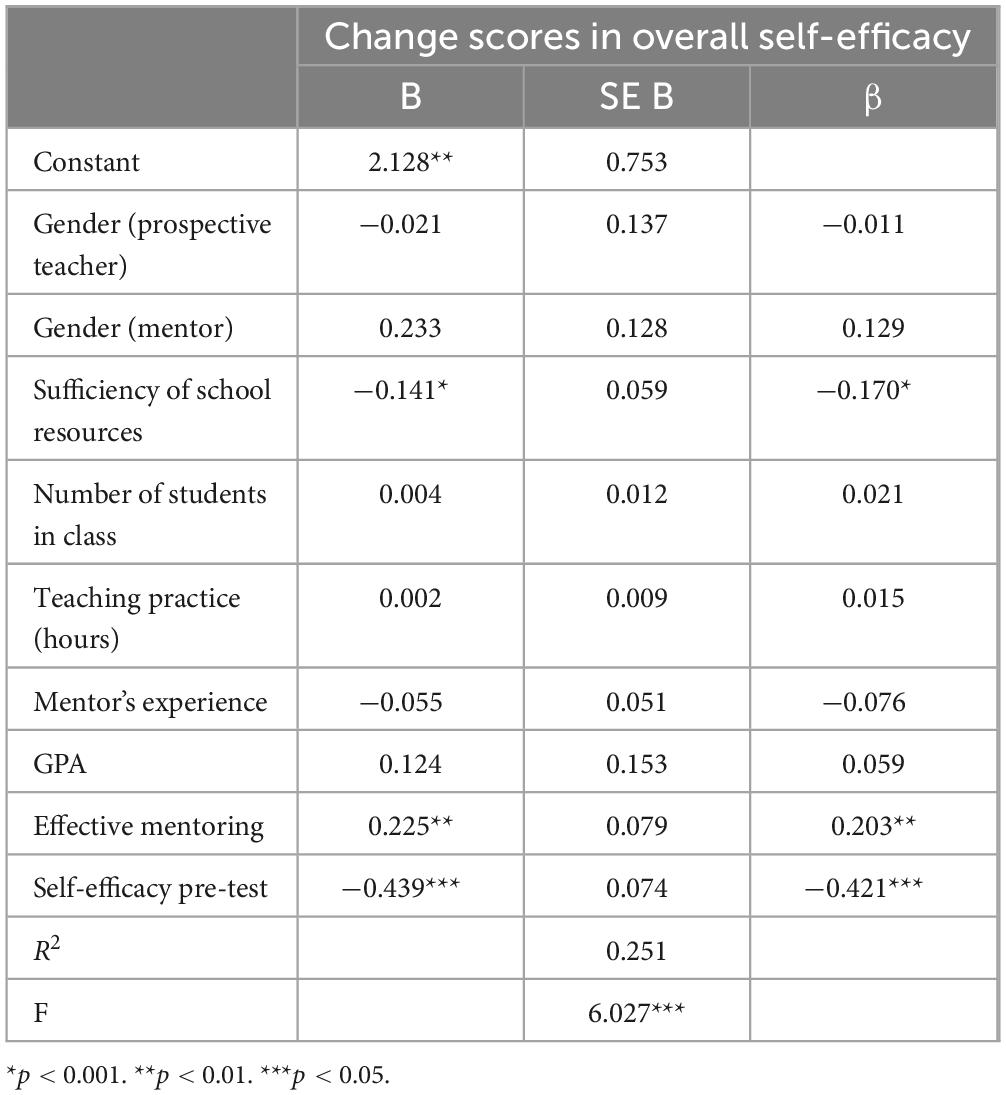
Table 8. Results of MLR analysis for predicting change scores of self-efficacy toward teaching science.
The regression equation for the change scores in overall self-efficacy is as follows:
Change scores in overall self-efficacy = 2.128 −0.021 Gender (Prospective teacher)+0.233 Gender (Mentor) −0.141 Sufficiency of school resources +0.004 Number of students in class +0.002 Teaching practice (hours) −0.055 Mentor’s experience +0.124 GPA +0.225 Effective mentoring −0.439 Self-efficacy pre-test.
To delve deeper into the exploration of predictors influencing self-efficacy change scores, the change scores for each subscale of self-efficacy were computed and employed as dependent variables. The outcomes of multiple linear regression (MLR) analyses conducted on these three subscales of self-efficacy revealed significant findings, as outlined in Table 9. Effective mentoring emerged as a positive and significant predictor for EIS (β = 0.166, p < 0.05), ECM (β = 0.148, p < 0.05), and ESE (β = 0.225, p < 0.01). Additionally, pre-test scores of EIS (β = −0.469, p < 0.001), ECM (β = −0.522, p < 0.001), and ESE (β = −0.422, p < 0.001) manifested as negative and significant predictors for changes in EIS, ECM, and ESE, respectively. Notably, the adequacy of school resources solely exhibited a significant and negative predictive association with changes in ECM (β = −0.150, p < 0.05). Collectively, the predictors within each model accounted for 27.0, 33.2, and 23.4% of the variances observed in the change scores of EIS, ECM, and ESE, respectively.
The regression equations for the change scores of EIS, ECM, and ESE are as follows, respectively:
Change scores of Efficacy for Instructional Strategies = 2.801 −0.075 Gender (Prospective teacher) +0.275 Gender (Mentor) −0.142 Sufficiency of school resources +0.006 Number of students in class +0.012 Teaching practice (hours) −0.041 Mentor’s experience +0.143 GPA +0.238 Effective mentoring −0.562 Pre-test scores EIS.
Change scores of Efficacy for Classroom Management = 2.880 +0.201 Gender (Prospective teacher) +0.168 Gender (Mentor) −0.148 Sufficiency of school resources +0.008 Number of students in class −0.008 Teaching practice (hours) −0.087 Mentor’s experience +0.168 GPA +0.196 Effective mentoring −0.551 Pre-test scores ECM.
Change scores of Efficacy for Student Engagement = 1.883 −0.166 Gender (Prospective teacher)+0.232 Gender (Mentor) −0.113 Sufficiency of school resources −0.004 Number of students in class +0.007 Teaching practice (hours) −0.018 Mentor’s experience +0.111 GPA +0.270 Effective mentoring −0.422 Pre-test scores ESE.
Discussion and conclusion
Impacts of TPC on PSTs with different initial levels of self-efficacy
With the aim of scrutinizing alterations in PSTs teaching self-efficacy after participation in the teaching practice course, the study’s findings unveiled distinct impacts of teaching practice durations on PSTs with different initial levels of self-efficacy. Specifically, the outcomes underscored the divergent effects of TPC on PSTs’ self-efficacy contingent upon their initial self-efficacy groupings. While individuals in the low self-efficacy (LSE) cohort demonstrated enhancements in their self-efficacy following the course, those with initially high levels of efficacy (HSE) witnessed a decline in their beliefs by its conclusion. This decline among highly efficacious participants could be attributed to a phenomenon wherein prospective teachers tend to underestimate the challenges of teaching before practical experience, subsequently experiencing a dip in their self-efficacy as they confront the dissonance between their perceived capabilities and actual performance. Conversely, the upsurge in self-efficacy levels among PSTs in the LSE group may be ascribed to the efficacious and invaluable teaching practices imparted during the TPC. This finding supports our prediction that it is important to focus on the differences in the initial self-efficacy levels of prospective teachers when examining their self-efficacy. Martins et al. (2015) indicated that prospective teachers exhibit diverse needs during the teaching practicum, and recommended that the mentoring process should be tailored to address the individual needs and strengths of each teacher candidate.
In the current study, the distinction between different participant groups underscores the significance of considering initial self-efficacy levels. Without this stratification, it is plausible that no significant difference would have emerged between pretest and posttest averages. Building upon insights from prior literature and the Attribution Theory of Intelligence (ATI) by Koran and Koran (1984), it was anticipated that initial self-efficacy levels would exert influence on outcomes—a conjecture validated by the findings. These results offer crucial support for the importance of accounting for initial self-efficacy levels in subsequent research endeavors. Furthermore, they corroborate the regression effect, positing that scores from studies involving extreme groups tend to converge toward the mean (Fraenkel et al., 2019).
The determinants of changes in self-efficacy
The second aim of this investigation is to identify the determinants of changes in PSTs’ self-efficacy, drawing from the sources of self-efficacy delineated by Bandura (1997). Notably, pre-test self-efficacy scores emerged as significant and positive predictors of alterations in overall teaching self-efficacy and its constituent dimensions, while the adequacy of school resources significantly and negatively affected changes in overall self-efficacy and efficacy for classroom management. Furthermore, the study unveiled that the quality of mentoring significantly influenced the augmentation of PSTs’ self-efficacy.
Firstly, a notable discovery was the inverse relationship observed between the adequacy of school resources and self-efficacy beliefs. While seemingly unexpected, this finding actually pertains to the utilization of laboratory facilities, as laboratories were exemplified as one of the school resources in the questionnaire. Existing research highlights teachers’ inadequate familiarity with the materials and equipment within science laboratories, resulting in their underutilization (Boyuk et al., 2010). Consequently, prospective teachers who observe such practices during the practicum may form unfavorable perceptions regarding using these resources. Tschannen-Moran et al. (1998) advocate for prospective teachers to initially gain teaching experience in less complex environments. It is arguably illogical to anticipate the development of robust self-efficacy beliefs in classrooms equipped with sophisticated laboratories before experiencing traditional classroom settings, which are comparatively less intricate. Thus, the observed decline in self-efficacy among PSTs embarking on instruction in complex classroom environments is not entirely surprising.
Secondly, our findings underscore the significance of Bandura (1986) identified sources of self-efficacy, particularly verbal persuasion and vicarious experiences. Effective mentoring during the TPC period, characterized by comprehensive guidance on the education system, pedagogical knowledge, exemplary teaching models, and constructive feedback, holds promise for enhancing PSTs’ self-efficacy in teaching. The self-efficacy of beginning teachers is enhanced by collaborative mentorship strategies that offer chances for practice reflection (Burger, 2024). As highlighted by Arslan (2019), the vigilance and feedback offered by university lecturers and mentor teachers to prospective teachers regarding their instructional methodologies harbor the potential to enhance their self-efficacy, thereby shaping their attitudes toward the teaching profession. This finding of this study supports the study of Moulding et al. (2014) who found a relationship between mentor support, which they attributed to providing comprehensive feedback on teaching practice, and self-efficacy of prospective teachers. Consistently, Martins et al.’s (2015) study underscores the influential role of experiences tied to verbal persuasion in bolstering self-efficacy.
Conversely, the present study did not establish a correlation between mastery experiences—here operationalized by the quantity of instructions delivered in real classroom settings—and PSTs’ self-efficacy. This finding is surprisingly contrary to the results of numerous studies in the literature, which assert that mastery experience is the most influential source of self-efficacy (e.g., Bandura, 1986; Al-Awidi and Alghazo, 2012; Martins et al., 2015). This result necessitates a cautious interpretation, as participants were solely queried about the duration of instruction delivery, without consideration of instructional content or quality. Bandura (1986) posited that unsuccessful mastery experiences, unlike successful ones, diminish self-efficacy. Notably, there are instances where mentor teachers may request prospective teachers to be present during idle class periods or fail to provide sufficient information regarding forthcoming lessons, potentially hindering the prospective teachers’ effective preparation and subsequently decreasing their self-efficacy. Therefore, it is plausible to infer that not all practicum lessons regarded as mastery experiences in this study were successful. It is likely that prospective teachers encountered both successful and unsuccessful mastery experiences in various courses, and these negative experiences may have adversely impacted their self-efficacy. In addition, the time allocated to prospective teachers to gain teaching experience in the current course may not be sufficient enough to make a difference in self-efficacy. Martins et al. (2015) found that some prospective teachers had low self-efficacy, especially for instructional strategies, during the teaching practicum process and, accordingly, stated that the development of self-efficacy through mastery experiences would be jeopardized if the teaching practicum only took place in the final year of initial teacher education.
Limitations and recommendations
This study has some limitations. First of all, since the study was conducted using quantitative methodology, focusing only on quantitative data can be considered a limitation. Conducting interviews with prospective teachers could yield richer insights into this phenomenon. As advocated by Ma and Cavanagh (2018), future research endeavors might adopt a more comprehensive research design integrating qualitative methodologies such as observation and interviewing to elucidate further aspects of prospective teachers’ self-efficacy. Moreover, considering that teacher self-efficacy both influence and is influenced by individual factors and the three theoretical sources of self-efficacy that are mastery experiences, vicarious experiences, and verbal persuasion should be interpreted in light of participants’ background as well as conceptual identity as Narayanan et al. (2023) suggested, conducting qualitative studies focusing on each participants’ identity might provide deeper insight into teacher self-efficacy. Another limitation is that in the present study physicological and emotional state being one of the sources of self-efficacy was not scrutinized. As Marschall (2023) underlines, the four sources of self-efficacy are interconnected in a loop, and they should be taken into account together. Thus, in future studies, recognizing the interaction among the four sources might contribute to the related literature. The study is also limited to one academic semester. Longitudinal research studies could be undertaken, and future investigations may encompass participants from a broader spectrum of prospective teachers across various stages of their initial teacher education programs. The fact that the study only worked with prospective science teachers also limits the findings. A comparative study of self-efficacy beliefs with prospective teachers from different branches might contribute to field.
In light of the study’s outcomes, recommendations for future research entail an initial stratification of prospective teachers’ self-efficacy into low and high groups, followed by a separate examination of these cohorts. It is also predicted that it would be beneficial for teacher educators to take into account that the needs of prospective teachers who start the teaching practicum process with different levels of self-efficacy may also be different in order to increase their self-efficacy levels during the prospective teacher education process. Therefore, they can make improvements in TPC by determining strategies that focus on these needs, such as increasing the quality of the mentoring process, conducting studies focusing on effective methods to use these resources in schools with facilities such as laboratories.
Data availability statement
The raw data supporting the conclusions of this article will be made available by the authors, without undue reservation.
Ethics statement
The studies involving humans were approved by the Kafkas University Ethics Committee. The studies were conducted in accordance with the local legislation and institutional requirements. The participants provided their written informed consent to participate in this study.
Author contributions
SY: Conceptualization, Data curation, Formal analysis, Funding acquisition, Investigation, Methodology, Project administration, Resources, Software, Supervision, Validation, Visualization, Writing – original draft, Writing – review & editing. YT: Conceptualization, Data curation, Formal analysis, Investigation, Methodology, Resources, Software, Supervision, Validation, Visualization, Writing – original draft, Writing – review & editing, AO: Conceptualization, Data curation, Investigation, Methodology, Resources, Supervision, Validation, Visualization, Writing – original draft, Writing – review & editing.
Funding
The authors declare that financial support was received for the research, authorship, and/or publication of this article. This work was supported by the Kafkas University Scientific Research Projects Commission under Grant 2016-EB-11.
Acknowledgments
In this study, a generative artificial intelligence technology called ChatGPT (version 3.5) was used only to assist in sentence editing and corrections for the English language. ChatGPT is an artificial intelligence model developed by OpenAI and based on GPT (Generative Pre-traid Transformer) architecture.
Conflict of interest
The authors declare that the research was conducted in the absence of any commercial or financial relationships that could be construed as a potential conflict of interest.
Publisher’s note
All claims expressed in this article are solely those of the authors and do not necessarily represent those of their affiliated organizations, or those of the publisher, the editors and the reviewers. Any product that may be evaluated in this article, or claim that may be made by its manufacturer, is not guaranteed or endorsed by the publisher.
References
Al-Awidi, H. M., and Alghazo, I. M. (2012). The effect of student teaching experience on preservice elementary teachers’ self-efficacy beliefs for technology integration in the UAE. Educ. Technol. Res. Dev. 60, 923–941.
Arslan, A. (2019). The mediating role of prospective teachers’ teaching self-efficacy between self-efficacy sources and attitude towards teaching profession. Int. J. Educ. Methodol. 5, 87–96. doi: 10.12973/ijem.5.1.101
Atay, D. (2007). Beginning teacher efficacy and the practicum in an EFL context. Teach. Dev. 11, 203–219. doi: 10.1080/13664530701414720
Bandura, A. (1977). Self-efficacy: Toward a unifying theory of behavioral change. Psychol. Rev. 84, 191–215. doi: 10.1037/0033-295X.84.2.191
Bandura, A. (1986). Social foundations of thought and action: A social cognitive theory. Hoboken, NJ: Prentice Hall.
Boyuk, U., Demir, S., and Erol, M. (2010). Analyzing the proficiency views of science and technology teachers on laboratory studies in terms of different varriables [Fen ve teknoloji dersi ogretmenlerinin laboratuvar calismalarina yonelik yeterlik goruslerinin farklı degiskenlere göre incelenmesi]. TUBAV Bilim Dergisi 3, 342–349.
Burger, J. (2024). Constructivist and transmissive mentoring: Effects on teacher self-efficacy, emotional management, and the role of novices’ initial beliefs. J. Teach. Educ. 75, 107–121. doi: 10.1177/00224871231185371
Capa, Y., Cakiroglu, J., and Sarıkaya, H. (2005). The development and validation of a Turkish version of teachers’ sense of efficacy scale. Educ. Sci. 30, 74–81.
Caprara, G. V., Barbaranelli, C., Steca, P., and Malone, P. S. (2006). Teachers’ self-efficacy beliefs as determinants of job satisfaction and students’ academic achievement: A study at the school level. J. Sch. Psychol. 44, 473–490. doi: 10.1016/j.jsp.2006.09.001
Chesnut, S. R., and Cullen, T. A. (2014). Effects of self-efficacy, emotional intelligence, and perceptions of future work environment on preservice teacher commitment. Teach. Educ. 49, 116–132. doi: 10.1080/08878730.2014.887168
Council of Higher Education [CHE] (2018). Teacher training undergraduate programs [Ogretmen yetistirme lisans programlari]. Çankaya: Council of Higher Education.
Ellis, N. J., Alonzo, D., and Nguyen, H. T. M. (2020). Elements of a quality pre-service teacher mentor: A literature review. Teach. Teach. Educ. 92:103072. doi: 10.1016/j.tate.2020.103072
Fackler, S., Malmberg, L. E., and Sammons, P. (2021). An international perspective on teacher self-efficacy: Personal, structural and environmental factors. Teach. Teach. Educ. 99:103255. doi: 10.1016/j.tate.2020.103255
Fraenkel, J., Wallen, N., and Hyun, H. (2019). How to design and evaluate research in education, 10th Edn. New York, NY: McGraw-Hill Education.
Gale, J., Alemdar, M., Cappelli, C., and Morris, D. (2021). A mixed methods study of self-efficacy, the sources of self-efficacy, and teaching experience. Front. Educ. 6:750599. doi: 10.3389/feduc.2021.750599
Hudson, P. B. (2006). “The status of mentoring preservice primary science teachers in Australia,” in Proceedings of the Practical Experiences in Professional Education (PEPE): Towards excellence in PEPE: A Collaborative Endeavour, (Auckland).
Jonson, K. F. (2008). Being an effective mentor: How to help beginning teachers succeed. Thousand Oaks, CA: Corwin press.
Jöreskog, K., and Sörbom, D. (2007). LISREL 8.8 for Windows [Computer Software and Manual]. Chicago, IL: Scientific Software International.
Kasalak, G., and Dağyar, M. (2020). The relationship between teacher self-efficacy and teacher job satisfaction: A meta-analysis of the teaching and learning international survey (TALIS). Educ. Sci. Theory Pract. 20, 16–33.
Kavanoz, S., Yüksel, H. G., and Özcan, E. (2015). Pre-service teachers’ self-efficacy perceptions on web pedagogical content knowledge. Comput. Educ. 85, 94–101. doi: 10.1016/j.compedu.2015.02.005
Klassen, R. M., and Tze, V. M. (2014). Teachers’ self-efficacy, personality, and teaching effectiveness: A meta-analysis. Educ. Res. Rev. 12, 59–76. doi: 10.1016/j.edurev.2014.06.001
Klassen, R. M., Tze, V. M., Betts, S. M., and Gordon, K. A. (2011). Teacher efficacy research 1998–2009: Signs of progress or unfulfilled promise? Educ. Psychol. Rev. 23, 21–43.
Klassen, R. M., Yerdelen, S., and Durksen, T. (2013). Measuring teacher engagement: Development of the engaged teachers scale (ETS). Frontline Learn. Res. 1, 33–52.
Koran, M. L., and Koran, J. J. (1984). Aptitude-treatment interaction research in science education. J. Res. Sci. Teach. 21, 793–808. doi: 10.1002/tea.3660210804
Ma, K., and Cavanagh, M. S. (2018). Classroom ready?: Pre-service teachers’ self-efficacy for their first professional experience placement. Aust. J. Teach. Educ. 43, 134–151. doi: 10.3316/ielapa.789564914636026
Ma, K., McMaugh, A., and Cavanagh, M. (2022). Changes in pre-service teacher self-efficacy for teaching in relation to professional experience placements. Aust. J. Educ. 66, 57–72. doi: 10.1177/00049441211060
Marschall, G. (2023). Teacher self-efficacy sources during secondary mathematics initial teacher education. Teach. Teach. Educ. 132:104203. doi: 10.1016/j.tate.2023.104203
Martins, M., Costa, J., and Onofre, M. (2015). Practicum experiences as sources of pre-service teachers’ self-efficacy. Eur. J. Teach. Educ. 38, 263–279. doi: 10.1080/02619768.2014.968705
Menon, D., and Azam, S. (2021). Investigating preservice teachers’ science teaching self-efficacy: An analysis of reflective practices. Int. J. Sci. Maths. Educ. 19, 1587–1607. doi: 10.1007/s10763-020-10131-4
Ministry of National Education [MoNE], (2018). Guidelines for teaching practice [Ögretmenlik uygulamasina ilişkin yönerge]. Available online at: https://oygm.meb.gov.tr/meb_iys_dosyalar/2018_06/25172143_YYnerge.pdf (accessed February 12, 2024).
Mok, S. Y., and Staub, F. C. (2021). Does coaching, mentoring, and supervision matter for pre-service teachers’ planning skills and clarity of instruction? A meta-analysis of (quasi-) experimental studies. Teach. Teach. Educ. 107:103484. doi: 10.1016/j.tate.2021.103484
Mok, S. Y., Rupp, D., and Holzberger, D. (2023). What kind of individual support activities in interventions foster pre-service and beginning teachers’ self-efficacy? A meta-analysis. Educ. Res. Rev. 40:100552. doi: 10.1016/j.edurev.2023.100552
Morris, D. B., Usher, E. L., and Chen, J. A. (2017). Reconceptualizing the sources of teaching self-efficacy: A critical review of emerging literature. Educ. Psychol. Rev. 29, 795–833. doi: 10.1007/s10648-016-9378-y
Moulding, L. R., Stewart, P. W., and Dunmeyer, M. L. (2014). Pre-service teachers’ sense of efficacy: Relationship to academic ability, student teaching placement characteristics, and mentor support. Teach. Teach. Educ. 41, 60–66. doi: 10.1016/j.tate.2014.03.007
Mulholland, J., and Wallace, J. (2001). Teacher induction and elementary science teaching: Enhancing self-efficacy. Teach. Teach. Educ. 17, 243–261. doi: 10.1016/S0742-051X(00)00054-8
Narayanan, M., Ordynans, J. G., Wang, A., McCluskey, M. S., Elivert, N., Shields, A. L., et al. (2023). Putting the self in self-efficacy: Personal factors in the development of early teacher self-efficacy. Educ. Urban Soc. 55, 175–200. doi: 10.1177/00131245211062528
Onofre, M., and Jardim, M. (2008). “The self-efficacy of preservice physical education teachers’ and it sources,” in Proceedings of the 13th annual congress of the european college of sport science, (Estoril).
Orakcı, Ş, Yüreğilli Göksu, D., and Karagöz, S. (2023). A mixed methods study of the teachers’ self-efficacy views and their ability to improve self-efficacy beliefs during teaching. Front. Psychol. 13:1035829. doi: 10.3389/fpsyg.2022.1035829
Perera, H. N., and John, J. E. (2020). Teachers’ self-efficacy beliefs for teaching math: Relations with teacher and student outcomes. Contemp. Educ. Psychol. 61:101842. doi: 10.1016/j.cedpsych.2020.101842
Philippou, G., and Charalambous, C. Y. (2005). Disentangling mentors’ role in the development of prospective teachers’ efficacy beliefs in teaching mathematics. Int. Group Psychol. Maths. Educ. 4, 73–80.
Samfira, E. M., and Paloş, R. (2021). Teachers’ personality, perfectionism, and self-efficacy as predictors for coping strategies based on personal resources. Front. Psychol. 12:751930. doi: 10.3389/fpsyg.2021.751930
Skaalvik, E. M., and Skaalvik, S. (2007). Dimensions of teacher self-efficacy and relations with strain factors, perceived collective teacher efficacy, and teacher burnout. J. Educ. Psychol. 99, 611–625. doi: 10.1037/0022-0663.99.3.611
Tabachnick, B. G., and Fidell, L. S. (2007). Using multivariate statistics, 5th Edn. London: Pearson.
Tschannen-Moran, M., and McMaster, P. (2009). Sources of self-efficacy: Four professional development formats and their relationship to self-efficacy and implementation of a new teaching strategy. Elem. Sch. J. 110, 228–245.
Tschannen-Moran, M., and Woolfolk Hoy, A. (2001). Teacher efficacy: Capturing an elusive construct. Teach. Teach. Educ. 17, 783–805.
Tschannen-Moran, M., Woolfolk Hoy, A., and Hoy, W. K. (1998). Teacher efficacy: Its meaning and measure. Rev. Educ. Res. 68, 202–248. doi: 10.3102/00346543068002202
Usher, E. L., and Pajares, F. (2009). Sources of self-efficacy in mathematics: A validation study. Contemp. Educ. Psychol. 34, 89–101. doi: 10.1016/j.cedpsych.2008.09.002
Verešová, M., and Malá, D. (2012). Stress, proactive coping and self-efficacy of teachers. Proc. Soc. Behav. Sci. 55, 294–300.
Woolfolk, A. E., Rosoff, B., and Hoy, W. K. (1990). Teachers’ sense of efficacy and their beliefs about managing students. Teach. Teach. Educ. 6, 137–148. doi: 10.1016/0742-051X(90)90031-Y
Wray, E., Sharma, U., and Subban, P. (2022). Factors influencing teacher self-efficacy for inclusive education: A systematic literature review. Teach. Teach. Educ. 117:103800. doi: 10.1016/j.tate.2022.103800
Yerdelen, S. (2013). Multilevel investigations of students’ cognitive and affective learning outcomes and their relationships with perceived classroom learning environment and teacher effectiveness. Unpublished doctoral dissertation. Ankara: Middle East Technical University.
Yerdelen, S., Durksen, T., and Klassen, R. (2018). An international validation of the engaged teacher scale. Teachers Teach. Theory Pract. 24, 673–689. doi: 10.1080/13540602.2018.145702
Yerdelen, S., and Sungur, S. (2019). Multilevel investigation of students’ self-regulation processes in learning science: Classroom learning environment and teacher effectiveness. Int. J. Sci. Math. Educ. 17, 89–110. doi: 10.1007/s10763-018-9921-z
Yerdelen, S., Taş, Y., and Sungur, S. (2012). “Predictors of pre-service science teacher self-efficacy,” Paper Presented at the Annual Meeting of European Conference on Educational Research (ECER), Cádiz.
Keywords: mentoring, prospective teachers, self-efficacy, sources of self-efficacy, teaching practice course
Citation: Yerdelen S, Tas Y and Osmanoglu A (2024) Investigating the change in prospective science teachers’ self-efficacy beliefs and the sources of this change during the teaching practice course. Front. Educ. 9:1427513. doi: 10.3389/feduc.2024.1427513
Received: 03 May 2024; Accepted: 23 July 2024;
Published: 08 August 2024.
Edited by:
Tanya Pinkerton, Arizona State University, United StatesReviewed by:
Ying-Chih Chen, Arizona State University, United StatesElena Mirela Samfira, University of Life Sciences, Romania
Copyright © 2024 Yerdelen, Tas and Osmanoglu. This is an open-access article distributed under the terms of the Creative Commons Attribution License (CC BY). The use, distribution or reproduction in other forums is permitted, provided the original author(s) and the copyright owner(s) are credited and that the original publication in this journal is cited, in accordance with accepted academic practice. No use, distribution or reproduction is permitted which does not comply with these terms.
*Correspondence: Sundus Yerdelen, c3V5ZXJkZWxlbkBnbWFpbC5jb20=
†Present address: Aslihan Osmanoglu, Department of Mathematics and Science Education, Ordu University, Ordu, Türkiye
 Sundus Yerdelen
Sundus Yerdelen Yasemin Tas
Yasemin Tas Aslihan Osmanoglu3†
Aslihan Osmanoglu3†
